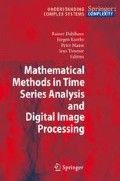Abstract
In the analysis of coupled systems, various techniques have been developed to model and detect dependencies from observed bivariate time series. Most well-founded methods, like Granger-causality and partial coherence, are based on the theory of linear systems: on correlation functions, spectra and vector autoregressive processes. In this paper we discuss a nonlinear approach using recurrence.
Access this chapter
We’re sorry, something doesn't seem to be working properly.
Please try refreshing the page. If that doesn't work, please contact support so we can address the problem.
Preview
Unable to display preview. Download preview PDF.
References
J.M. Amigó, M.B. Kennel, and L. Kocarev. The permutation entropy rate equals the metric entropy rate for ergodic information sources and ergodic dynamical systems. Physica D, 210(l–2):77–95, 2005.
J.H. Argyris, G. Faust, and M. Haase. An Exploration of Chaos. North Holland, Amsterdam, 1994.
C. Bandt. Ordinal time series analysis. Ecological Modelling, 182: 229–238, 2005.
C. Bandt and B. Pompe. Permutation entropy: A natural complexity measure for time series. Physical Review Letters, 88:174102, 2002.
C. Bandt and F. Shiha. Order patterns in time series. Journal of Time Series Analysis, 28:646–665, 2007.
C. Bandt, G. Keller, and B. Pompe. Entropy of interval maps via permutations. Nonlinearity, 15:1595–1602, 2002.
R. Durbin, S. Eddy, A. Krogh, and G. Mitchison, editors. Biological Sequence Analysis. Cambridge University Press, Cambridge, 1998.
J.-P. Eckmann, S.O. Kamphorst, and D. Ruelle. Recurrence plots of dynamical systems. Europhysics Letters, 4:973–977, 1987.
T.S. Ferguson, C. Genest, and M. Hallin. Kendall’ tau for serial dependence. The Canadian Journal of Statistics, 28(3):587–604, 2000.
S. Frisch, P. beim Graben, and M. Schlesewsky. Parallelizing grammatical functions: P600 and p345 reflect different cost of reanalysis. International Journal of Bifurcation and Chaos, 14(2):531–549, 2004.
A. Goettlein and H. Pruscha. Advances in GLIM and Statistical Modeling, volume 78, pages 113–118. Springer, New York, 1992.
A. Groth. Visualization of coupling in time series by order recurrence plots. Physical Review E, 72:046220, 2005.
M. Hallin and J. Jurečkova. Optimal tests for autoregressive models based on autoregression rank scores. The Annals of Statistics, 27(4): 1385–1414, 1999.
T.C. Handy, editor. Event-Related Potentials. MIT Press, Cambridge, Mass., 2005.
H. Kantz and T. Schreiber. Nonlinear Time Series Analysis. Cambridge University Press, Cambridge, second edition, reprint edition, 2005.
M.G. Kendall and J.D. Gibbons. Rank Correlation Methods. Oxford University Press, New York, 5th edition, 1990.
I.Z. Kiss, Q. Lv, and J.L. Hudson. Synchronization of non-phase coherent chaotic electrochemical oscillations. Physical Review E, 71:035201, 2005.
E.N. Lorenz. Deterministic nonperiodic flow. Journal of the Atmospheric Sciences, 20:120–141, 1963.
N. Marwan and J. Kurths. Nonlinear analysis of bivariate data with cross recurrence plots. Physics Letters A, 302(5–6):299–307, 2002.
N. Marwan, M.C. Romano, M. Thiel, and J. Kurths. Recurrence plots for the analysis of complex systems. Physics Reports, 438(5–6):237–329, 2007.
F. Mormann, K. Lehnertz, P. David, and C.E. Elger. Mean phase coherence as a measure for phase synchronization and its application to the eeg of epilepsy patients. Physica D, 144:358–369, 2000.
G. Osipov, B. Hu, C. Zhou, M. Ivanchenko, and J. Kurths. Three types of transition to phase synchronization in coupled chaotic oscillators. Physical Review Letters, 91(2):024101, 2003.
K. Petersen. Ergodic Theory. Cambridge University Press, Cambridge, 1983.
A. Pikovsky, M. Rosenblum, and J. Kurths. Synchronization — A Universal Concept in Nonlinear Sciences. Cambridge University Press, Cambridge, 2003.
R. Quian Quiroga, T. Kreuz, and P. Grassberger. Event synchronization: A simple and fast method to measure synchronicity and time delay patterns. Physical Review E66:041904, 2002.
M.C. Romano, M. Thiel, J. Kurths, I.Z. Kiss, and J.L. Hudson. Detection of synchronization for non-phase-coherent and non-stationary data. Europhysics Letters, 71(3):466–472, 2005.
M.C. Romano, M. Thiel, J. Kurths, and W. von Bloh. Multivariate recurrence plots. Physics Letters A, 330(3–4):214–223, 2004.
M. Rosenblum, A. Pikovsky, and K. Kurths. Phase synchronization of chaotic oscillators. Physical Review Letters, 76(11):1804–1807, 1996.
M.G. Rosenblum, A.S. Pikovsky, and J. Kurths. From phase to lag synchronization in coupled chaotic oscillators. Physical Review Letters, 78(22):4193–4196, 1997.
O.E. Rössler. An equation for continuous chaos. Physics Letters A, 57(5):397–398, 1976.
T. Sauer, J.A. Yorke, and M. Casdagli. Embedology. Journal of Statistical Physics, 65(3–4):579–616, 1991.
R.H. Shumway and D.S. Stoffer. Time Series Analysis and Its Applications. Springer, New York, 2006.
O.V. Sosnovtseva, A.G. Balanov, T. E. Vadivasova, V. V. Astakhov, and E. Mosekilde. Loss of lag synchronization in coupld chaotic systems. Physical Review E, 60(6):6560–6565, 1999.
S.S. Stevens. On the theory of scales of measurement. Science, 103: 677–680, 1946.
F. Takens. Detecting strange attractors in turbulence. Lecture Notes in Mathematics, volume 898, pages 366–381. Springer, Berlin, 1981.
P. Tass, M. Rosenblum, J. Weule, J. Kurths, A. Pikovsky, J. Volkmann, A. Schnitzler, and H.-J. Freund. Detection of n:m phase locking from noisy data: Application to magnetoencephalography. Physical Review Letters, 81(15):3291–3294, 1998.
M. Thiel, M.C. Romano, P.L. Read, and J. Kurths. Estimation of dynamical invariants without embedding by recurrence plots. Chaos, 14(2):234–243, 2004.
J.P. Zbilut and Charles L. Webber, Jr. Embeddings and delays as derived from quantification of recurrence plots. Physics Letters A, 171(3–4): 199–203, 1992.
Author information
Authors and Affiliations
Editor information
Editors and Affiliations
Rights and permissions
Copyright information
© 2008 Springer-Verlag Berlin Heidelberg
About this chapter
Cite this chapter
Bandt, C. et al. (2008). Analysis of Bivariate Coupling by Means of Recurrence. In: Dahlhaus, R., Kurths, J., Maass, P., Timmer, J. (eds) Mathematical Methods in Signal Processing and Digital Image Analysis. Understanding Complex Systems. Springer, Berlin, Heidelberg. https://doi.org/10.1007/978-3-540-75632-3_5
Download citation
DOI: https://doi.org/10.1007/978-3-540-75632-3_5
Publisher Name: Springer, Berlin, Heidelberg
Print ISBN: 978-3-540-75631-6
Online ISBN: 978-3-540-75632-3
eBook Packages: Physics and AstronomyPhysics and Astronomy (R0)

